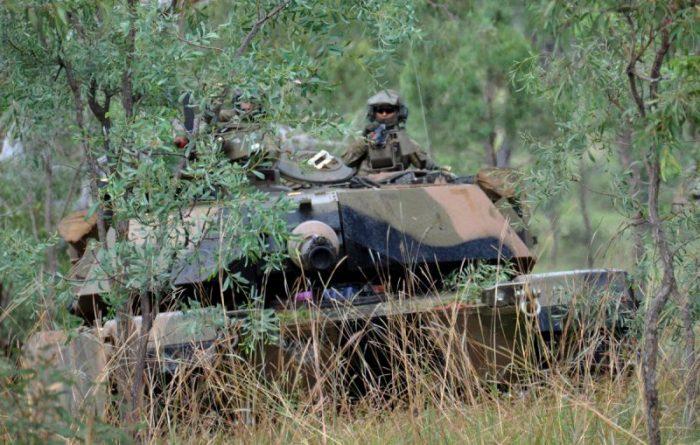Reviewing the Department of Defence (part 1)
Posted By Graeme Dobell on November 18, 2019 @ 06:00

Australia’s Defence Department is a big beast that’s hard to ride, much less steer.
The complexities of kit, costs and strategy [1] have made it the most inquiry-prone animal in Canberra—50 reviews in five decades (35 significant reviews and many more supplementary reviews).
As the most recent major report on the defence organisation—the first principles review [2]—noted in 2015: ‘The sheer frequency of reviews over the past decade has meant that many were short-lived or simply overtaken by the next review. Often the recommended changes were not allowed to bed in before another review began.’
If any of the answers were simple or cheap, they’d have been implemented long ago. The beast shifts slowly as reviews come and go.
Arthur Tange’s revolution [3] in 1973 started the long journey to transform the defence herd into a single beast and make the military tribes one. Tange’s creation has a diarchic brain, with military and civilian sides; the creature spends a lot of energy just connecting its thoughts. After five decades of evolution, the habits and habitat of today’s Russell Hill would still look rather familiar to Tange.
The first principles review found that Defence’s way of doing things was ‘complicated, slow and inefficient in an environment which requires simplicity, greater agility and timely delivery. Waste, inefficiency and rework are palpable. Defence is suffering from a proliferation of structures, processes and systems with unclear accountabilities.’
Savour that recurring lament of reviews through the decades.
Reviews happen for many reasons. Oppositions pledge to overhaul Defence as one of their promises to remake Canberra; and if they win power, a review is a promise that can be kept.
Governments usually order reviews to tackle a bothersome headache or damp a crisis. After some time in office, though, they might reach for an all-purpose shake-up to express frustration, even anger [4], at the cost and complexity of the creature.
Defence white papers and strategic reviews are a special genre, a form of self-analysis using a geopolitical crystal ball and an equipment wish list. The beast tries to explain itself to government (and itself) while looking out from Russell at what’s happening in other parts of the jungle.
In line with the big beast metaphor, Peter Jennings channelled his inner naturalist to describe the lifecycle of a defence review as though it were a gnu or wildebeest [5] roaming the grasslands. Under wonderful punny headlines ‘nothing Gnu here’ [6] and ‘no Gnus is good news’ [7], he records the tough truth that few reviews survive long enough to be fully implemented: ‘Just as for Gnus in Africa, life is brutal and short on the policy veldt. Many reviews get trampled underfoot by newer processes.’
Life is hard for reviews because Defence’s problems aren’t just complex and costly; they reach beyond vital towards existential. As an example, see Paul Dibb’s [8] account of why he was asked to report on Australia’s defence capabilities in 1985 (one of the reviews that lived long enough to have a real impact).
Dibb was called in after 12 months of internal argument, when Defence couldn’t ‘come to even a preliminary agreement on force structure priorities for the defence of Australia’. Ponder that. Defence couldn’t answer the question that’s the heart of its existence: how do we defend Oz? The diarchic brain was in turmoil.
Dibb describes the entrenched differences between the senior military and civilian hierarchies:
The secretary and the chief of the defence force had got bogged down in exchanging 130 classified memos about the theology of defence policy on such concepts as defence warning time; low-level conflict; more substantial conflict; and whether Australia’s unique geography should basically determine its force structure, as distinct from expeditionary forces for operations at great distance from Australia. Most of the ensuing debate was not constructive: it was hostile with little agreement on even basic principles for force structure priorities.
As the outsider, Dibb says his main policy aim was to get a ‘workable compromise between these bitterly held positions’.
Workable compromise is the spur of choice for the beast.
To be continued …
Article printed from The Strategist: https://aspistrategist.ru
URL to article: /reviewing-the-department-of-defence-part-1/
URLs in this post:
[1] kit, costs and strategy: /australias-defence-the-tangle-of-kit-costs-and-complexity/
[2] first principles review: https://www.defence.gov.au/Publications/Reviews/Firstprinciples/
[3] Arthur Tange’s revolution: /the-new-and-old-testaments-of-defence/
[4] frustration, even anger: /the-big-beast-that-is-the-defence-department/
[5] gnu or wildebeest: https://en.wikipedia.org/wiki/Wildebeest
[6] ‘nothing Gnu here’: /defence-reviews-nothing-gnu-here/
[7] ‘no Gnus is good news’: /defence-reviews-no-gnus-is-good-news/
[8] Paul Dibb’s: /revisiting-the-north-in-the-defence-of-australia/
Click here to print.